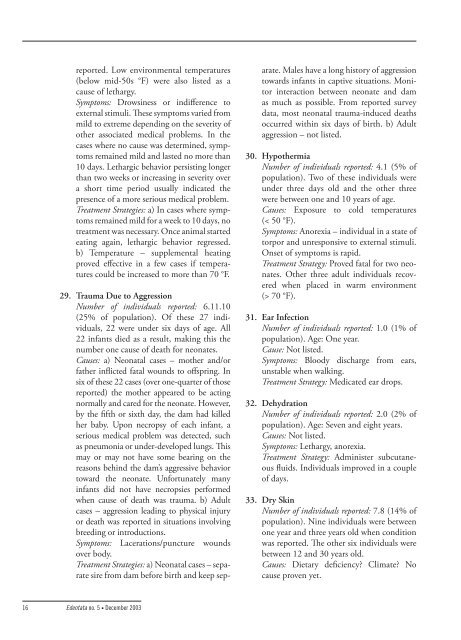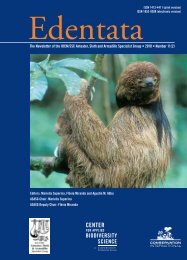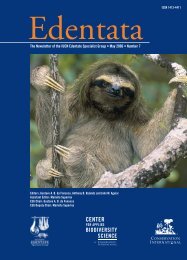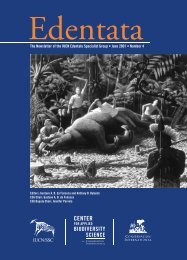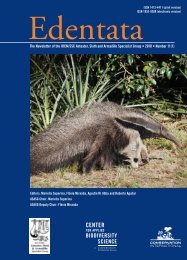Edentata 5 - Anteater, Sloth & Armadillo Specialist Group
Edentata 5 - Anteater, Sloth & Armadillo Specialist Group
Edentata 5 - Anteater, Sloth & Armadillo Specialist Group
You also want an ePaper? Increase the reach of your titles
YUMPU automatically turns print PDFs into web optimized ePapers that Google loves.
eported. Low environmental temperatures(below mid-50s °F) were also listed as acause of lethargy.Symptoms: Drowsiness or indifference toexternal stimuli. ese symptoms varied frommild to extreme depending on the severity ofother associated medical problems. In thecases where no cause was determined, symptomsremained mild and lasted no more than10 days. Lethargic behavior persisting longerthan two weeks or increasing in severity overa short time period usually indicated thepresence of a more serious medical problem.Treatment Strategies: a) In cases where symptomsremained mild for a week to 10 days, notreatment was necessary. Once animal startedeating again, lethargic behavior regressed.b) Temperature – supplemental heatingproved effective in a few cases if temperaturescould be increased to more than 70 °F.29. Trauma Due to AggressionNumber of individuals reported: 6.11.10(25% of population). Of these 27 individuals,22 were under six days of age. All22 infants died as a result, making this thenumber one cause of death for neonates.Causes: a) Neonatal cases – mother and/orfather inflicted fatal wounds to offspring. Insix of these 22 cases (over one-quarter of thosereported) the mother appeared to be actingnormally and cared for the neonate. However,by the fifth or sixth day, the dam had killedher baby. Upon necropsy of each infant, aserious medical problem was detected, suchas pneumonia or under-developed lungs. ismay or may not have some bearing on thereasons behind the dam’s aggressive behaviortoward the neonate. Unfortunately manyinfants did not have necropsies performedwhen cause of death was trauma. b) Adultcases – aggression leading to physical injuryor death was reported in situations involvingbreeding or introductions.Symptoms: Lacerations/puncture woundsover body.Treatment Strategies: a) Neonatal cases – separatesire from dam before birth and keep separate.Males have a long history of aggressiontowards infants in captive situations. Monitorinteraction between neonate and damas much as possible. From reported surveydata, most neonatal trauma-induced deathsoccurred within six days of birth. b) Adultaggression – not listed.30. HypothermiaNumber of individuals reported: 4.1 (5% ofpopulation). Two of these individuals wereunder three days old and the other threewere between one and 10 years of age.Causes: Exposure to cold temperatures(< 50 °F).Symptoms: Anorexia – individual in a state oftorpor and unresponsive to external stimuli.Onset of symptoms is rapid.Treatment Strategy: Proved fatal for two neonates.Other three adult individuals recoveredwhen placed in warm environment(> 70 °F).31. Ear InfectionNumber of individuals reported: 1.0 (1% ofpopulation). Age: One year.Cause: Not listed.Symptoms: Bloody discharge from ears,unstable when walking.Treatment Strategy: Medicated ear drops.32. DehydrationNumber of individuals reported: 2.0 (2% ofpopulation). Age: Seven and eight years.Causes: Not listed.Symptoms: Lethargy, anorexia.Treatment Strategy: Administer subcutaneousfluids. Individuals improved in a coupleof days.33. Dry SkinNumber of individuals reported: 7.8 (14% ofpopulation). Nine individuals were betweenone year and three years old when conditionwas reported. e other six individuals werebetween 12 and 30 years old.Causes: Dietary deficiency? Climate? Nocause proven yet.16 <strong>Edentata</strong> no. 5 • December 2003


